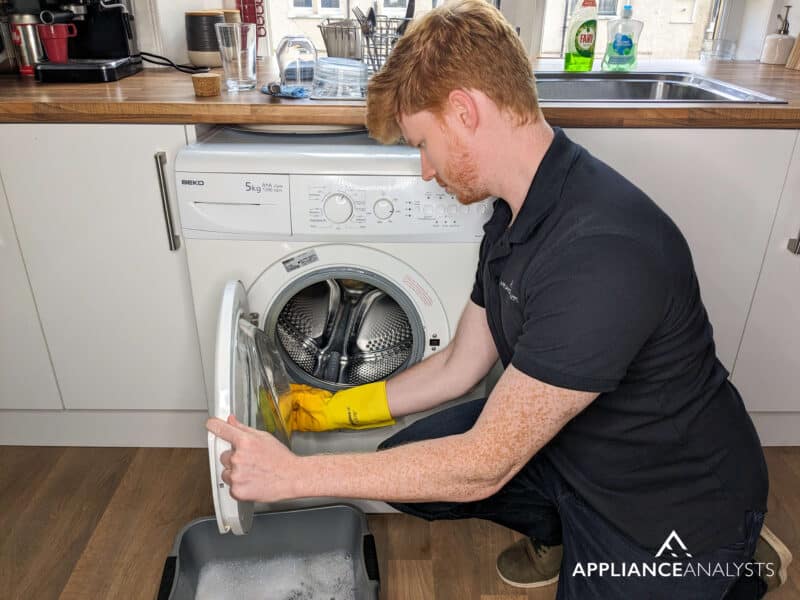We've independently reviewed this article to make sure it's as accurate as we can make it.
To find out more about our article creation and review process, check out our editorial guidelines.
Is your washer tearing holes in your clothes, and you’re desperately looking for a solution?
You’re not alone! Thousands of people struggle with washers that seem to have a personal vendetta against their favorite outfits daily.
I know how annoying having your washer keep tearing holes in your clothes can be. But don’t worry; you’ve come to the right place for answers.
Below, you’ll find a list including 5 simple fixes you can try to stop the problem immediately and get everything back to normal.
When your washer keeps tearing holes in your clothes, try checking the agitator, monitoring the water level, and looking closer at the alignment in the transmission assembly. You’ll also want to consider damage to the door boot, a broken weight, or a bad bearing.
Keep reading to protect your clothes!
Why Your Washer Is Tearing Holes in Your Clothes
Many reasons can explain why your washer is tearing holes in your clothes – from something simple, like a water level problem, to a more concerning situation, such as a broken washer weight.
From the two main washer types (front-load and top-load), top-load variants are more likely to tear your clothes.
Here are some solutions for every washer type.
Top-Load Washers
Top-load washers have certain advantages over their front-load counterparts, but they’re not without issues. One of the main common components that can cause problems with your clothes is the agitator – the large pillar in the middle of the drum that helps the washer spin.
To address your top-load washer issues, please read the following sections carefully.
#1 Check the Agitator
The first thing I advise you to check when your washer is tearing holes in your clothes is the agitator.
In many cases, clothes can get caught between the basket and the agitator (only applicable to top load washers, as front load variants don’t have an agitator), causing them to tear and sustain other types of damage.

I’ve found that when your clothes get stuck, your appliance is also at risk of overheating, as the motor will have to struggle significantly to keep the drum turning and the washing process going.
Solution: The first thing you’ll want to try when you suspect to be in this situation is to ensure the agitator is not loose. To tighten the agitator, simply tighten the screw holding it in place. Depending on the washer brand and model you own, the location of the screw will vary. Please check your User Manual for reference.
If you don’t have the manual handy, check out our free resource below to find it online.
Assuming the agitator isn’t loose, you’ll also want to look closely and try to spot foreign objects (like coins) that may be stuck between the agitator and the basket.
#2 Monitor the Water Level
Ensuring the right water levels during a washing cycle is key to preventing your washer from tearing holes in your clothes.
Ideally, your washer already knows the right amount of water needed for each cycle, but sometimes, you’ll have to double-check to stay ahead of any issues.
A good sign that there’s enough water in your washer during a cycle is that the clothes can be easily submerged by pressing down on them.
Solution: If you notice your clothes cannot be fully submerged, there’s likely an issue with your washer. My usual advice is to contact a professional for assistance and repairs on the right components.
#3 Check the Transmission’s Alignment
Listening for unusual noises can go a long way in determining why your washer is tearing holes in your clothes.
During the agitation part of the washing cycle, grinding or rattling noises might indicate misalignment in either the agitator or its transmission.
Solution: When I see a misaligned agitator or transmission, I typically recommend calling an expert to take a look at address the issue. Sometimes, repair or replacement of a certain component will be necessary, but a simple realignment can do the trick in other cases.
Front Load Washers
Having covered all potential issues related to top-load washers and their agitators, let’s now move on to discussing front-load models.
Below, I’ll walk you through some of the most common causes behind your washer tearing holes in your clothes and certain solutions you can implement to address the problem.
#4 Check the Door Boot
Your washer’s door boot, also known as door seal or gasket, is a rubber circle that ensures no water comes out of the drum and into your laundry room’s floor.
Holes torn in your clothes during a cycle can indicate something stuck between the washer’s drum and the frame ripping through your garments.

Solution: If there’s a cycle active, stop it or wait until it’s. Then, wait for all the water in the drum to drain to prevent leaks from opening the door.
Carefully inspect the door boot (seal) to see whether any foreign objects are responsible for the damage to your clothes, and remove any should you find them.
I find that even small coins and paper clips can leave your clothes tattered and useless.
#5 Check the Weight/Bearing
The last possible reason why your front-load washer is tearing holes in your clothes is a broken washer weight/bearing.
The weight in your washer helps stabilize the drum as it rotates during a cycle. Washer weights are carefully calibrated to ensure the best balance possible, but things can quickly take a turn for the worse when there’s any damage in them.
The bearing also plays a key role in how your front-load washer works, as it makes it possible for the drum to turn on its axis.
In my experience, common signs that either or both components are being affected in some way are loud noises and vibrations during the spin cycle.
Solution: Similar to other issues on the list, a broken washer weight or damaged bearing will require professional inspection.
While trying to attempt the repair yourself can sometimes work, when the issue is complex, it might be cheaper to get a technician. Certified professionals typically have price arrangements with spare part vendors and manufacturers. If they misdiagnose an issue, they might offer a discount on their cost of labor.
General Recommendations
The best tool for diagnosing a faulty washer is to look and listen closely for anything that sounds out of the ordinary.
Also, if you know your washer’s brand and model number, you can look it up online along with the keywords “tearing clothes bulletin” to see whether there are known issues and solutions. Sometimes, after receiving complaints from several customers, manufacturers look into an issue and determine if there’s a common culprit, which they then post to help others who are struggling.
Keeping Your Washer From Destroying Your Clothes
That about covers it!
When your washer is tearing holes in your clothes, it’s understandable that you feel frustrated as you’ll not only have to cover the cost of repairs but also the cost of new clothes.
Luckily, as I hope this piece has helped you better understand, addressing the most common causes behind a washer that’s tearing holes in your clothes is easy and quick. More often than not, simple things, like checking for coins and other sharp objects that are stuck in the door boot, will do the trick.
Thanks for reading. If this article was useful and answered your questions, please check out our other resources below and consider subscribing to our newsletter.
Have a wonderful day!
-Craig.









